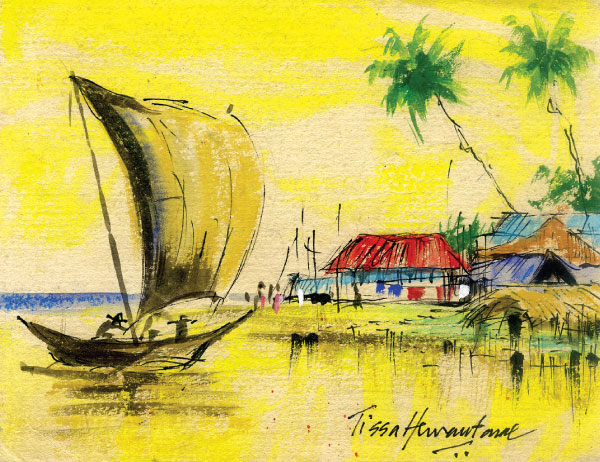Learn to draw
By Tissa Hewavitarane
Pencil, crayon and charcoal ideal for painting
Pencil, crayon and charcoal are easy to work with because of the
multitude of colours and tones available. They also have a great variety
of strength.
Pencils have a range from delicacy of F (a draughtsman's pencil) to
the heaviness of all or even E. Charcoal and carbon come in great big
thick pieces of fine sticks.
Crayon can be hard, soft or waxy and some are even water soluble. The
fluidity and the best results of your drawing will depend on the paper
you use.
A fine hard pencil will ripple and jump over a heavily textured
surface, but will produce a fine line on a smooth paper. You have to
choose both pencil and paper according to the final painting you want to
create.

Shape
When you have decided on the pencil you want, try to get the right
shape. Experiment by holding the pencil on its point or side or at a
slant. Each position creates a different mark. To emphasise thin lines
use the point but to get a broader stroke, you can use an eraser or a
putty rubber.
There are various drawing paper to give different effects and
techniques in pencil drawing as well as crayon. By working on cartridge
drawing paper the flow of the pencil and the broadness will show the
effects of shading without much effort. Any drawing done on sketchbook
paper using a 2B pencil gives a pattern and a texture of the whole
drawing. To strengthen the strokes perhaps it would be necessary to use
a 4B or a 6B pencil.
The drawing shown here of a seaside scene on crayon shows light and
colour. Crayons have a lot to offer in terms of freshness of colour and
immediacy and work well even with other material. There is a marvellous
variety of crayons available, which includes soft, hard and 'scenic'
crayons. They all have their own qualities.Crayons can be applied to a
variety of paper, including cardboard and toned papers which can glow
through and enhance crayon colours. Soft crayons can be broken with your
fingers and ground or smudged on to the surface of a paper to create the
effect of a wash crayon work well, too over watercolour or etching.
The painting done here is based on applying several colours. Observe
the painting, the eye is always drawn to the human figure. On the right
the eye travels to the foreground objects which are the huts and to
coconut trees and into the main part of the painting travels around from
object to object.
The centre of interest is the fishing boat. To make the picture more
live, I have introduced two figures in dark tones chatting in the boat.
The smoothness of the sky has been achieved by rubbing the chalk with
the thumb.
You can also do this with a putty rubber. Manipulating light and
understanding colour are important. The strength of colour gives the
painting a secret quality. The values in a picture actually affects our
eyes like musical notes affect our ears. |

